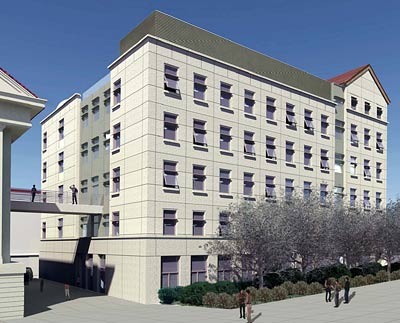NIST funds new high-precision, quantum measurement lab
| 25 November 2008
BERKELEY — An $11 million grant from the National Institute of Standards and Technology (NIST) will help the University of California, Berkeley, build a state-of-the-art precision measurement laboratory in the planned new home for the astronomy department and part of the physics department.
The award, announced yesterday (Nov. 24), was one of three NIST grants totaling $24 million to build research facilities at universities that will advance technologies and research in line with the mission of the Department of Commerce, which oversees NIST.
 An architectural drawing of the planned replacement for Campbell Hall, showing the bridge between LeConte Hall (left) and the third floor of the new research building. While the building will remain the home of the astronomy department, it also will accommodate physics department laboratories, including high-precision measurement labs in the basement.
An architectural drawing of the planned replacement for Campbell Hall, showing the bridge between LeConte Hall (left) and the third floor of the new research building. While the building will remain the home of the astronomy department, it also will accommodate physics department laboratories, including high-precision measurement labs in the basement."We are hoping for a project start date in 2010. Construction of the new building is one of the campus's high priorities," said Mark Richards, dean of the mathematical and physical sciences in the College of Letters and Science.
The physics department has been in need of new low-noise, low-vibration laboratory space for years. In Birge Hall, physicists have been known to conduct experiments in the middle of the night when ground vibrations from passing trucks are minimal, and have even postponed experiments until weekends or holidays to be able to turn off ventilation equipment and elevators to reduce vibrations.
"It is critical we have low vibration, low acoustical noise, and low electromagnetic interference because we are trying to measure very small signals for these very precise measurements," said Michael Crommie, professor of physics and leader of the CIPQM. "If you have too much noise, then it contaminates the measurements and obscures the science we're trying to study."
Crommie himself uses scanning tunneling microscopy to study the atomic-level physics of materials. "I use a sharp metal needle to probe individual atoms and molecules, and I need to keep that needle stable," he said. "If it moves by a small fraction of the diameter of a single atom, then that completely screws up my measurement. If the room is shaking and vibrating, then the measurement needle vibrates, too."
Other researchers use laser tables with many precisely aligned mirrors to conduct measurements where it is critical to keep alignments to within a fraction of the wavelength of light. If these mirrors vibrate, such measurements are impossible.
The need to either retrofit or rebuild Campbell Hall because of its poor seismic rating offered an opportunity to construct a basement laboratory in which to conduct what Crommie calls "fabulous new high-quality, high-precision experiments that are very much in tune with the mission of NIST."
As summarized in UC Berkeley's proposal to NIST, research to be conducted in the CIPQM will include: the application of atomically-resolved microscopy to observe dynamical processes at the nanoscale; quantum nanomechanics, an emerging discipline focused on the measurement and control of mechanical properties of nanostructures; interferometry with ultracold atoms, with applications ranging from basic research on fundamental physics to ultra-high precision gyroscopes and gravitational field detectors; solid-state magnetometers and amplifiers at the quantum limit, a precision measurement field with many applications in physics, earth exploration and medical devices that sense faint magnetic fields; and advanced optical metrology techniques at the nanoscale.
The 10,000-square-foot space will comprise 10 to 15 high-quality modular laboratories that could house researchers from a range of disciplines, including physics, electrical engineering, chemistry and molecular and cell biology.

